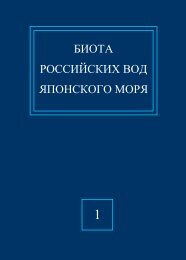Analyse, Problemen, Rekonstruktion - Materials of Alexey Shipunov
Analyse, Problemen, Rekonstruktion - Materials of Alexey Shipunov
Analyse, Problemen, Rekonstruktion - Materials of Alexey Shipunov
Erfolgreiche ePaper selbst erstellen
Machen Sie aus Ihren PDF Publikationen ein blätterbares Flipbook mit unserer einzigartigen Google optimierten e-Paper Software.
goniopterum. Anderes Beispiel, auf meinen<br />
Blick, verdient der besonderen<br />
Aufmerksamkeit und kann nicht ohne<br />
ausführliche Kommentare bleiben. Ich sage<br />
über Ahlbergia arquata.<br />
Ahlbergia arquata Johnson, 1992<br />
(JOHNSON, 1992: 27 - 28; figs. 14, 15, 64)<br />
war aus «Andijan, E.Turkestan [now<br />
Usbekistan …] beschrieben, U.S.R.» (nach<br />
Holotypus) (wird Holotypus in Muséum<br />
national d'Histoire naturelle in Paris)<br />
bewahrt. Ist laut der Originalbeschreibung,<br />
stammen die typisierten Exemplare dieser<br />
Art aus der Gegend «Andijan» und früher als<br />
wurden in die Kollektion STEMPFFER<br />
bewahrt. Wie die Erweiterung zum<br />
Aufenthalt der Arten «E.Turkestan»<br />
zugeschrieben ist. Doch ist E.Turkestan und<br />
es existiert der Bezirk Südlichen Gissares,<br />
und hier gibt es den besiedelten Punkt mit<br />
der Benennung Andishan.<br />
Originalbeschreibung:<br />
«Diagnosis.<br />
Most similar to sister species A. leei but<br />
very large (FW circa 13.0 mm), with upper<br />
surface indescent blue brighter than on any<br />
other congener and under surface ground<br />
coloration extremely light, alternating white<br />
and gray, causing hindwing banded elements<br />
to be extremely outstanding. Known<br />
distribution restricted far westward from<br />
congeners – in the Tadzhik, Kirghiz and Tien<br />
Shan mountain regions. Male genitalia with<br />
extremely shouldered bilobes and a long,<br />
abruptly tapered caudal extension; female<br />
genitalia with ductus bursae extremely short<br />
(expanse nearly equal to the lamellal<br />
breadth) and widely convoluted ventral<br />
surfaces on the lamella postvaginalis.<br />
Description.<br />
Male: Head, thorax, abdomen, legs,<br />
pupal and frons typical <strong>of</strong> the genus. Upper<br />
Surface <strong>of</strong> the Wings: Ground colors fuscous<br />
but suffused brightly with blue nearly <strong>of</strong> the<br />
postmedial areas. Forewing with scent brand<br />
in distal area <strong>of</strong> discal cell. Margins<br />
generally gray and slightly crenate with<br />
hindwing anal lobe pronounced. Under<br />
Surface <strong>of</strong> the Wings: Ground colors <strong>of</strong><br />
forewings generally dark brown with<br />
somewhat lighter brown distal <strong>of</strong> a<br />
pronounced black postmedian line.<br />
Hindwings with basal disc blackish brown,<br />
vivdly contrasting a lighter auburn brown<br />
ground in medial to postmedial areas and<br />
with emphatic gray-white basad <strong>of</strong> the basal<br />
disc and in the distal postmedial areas.<br />
Because <strong>of</strong> the light grey grounds, the dark<br />
brown motted crescent-like bands <strong>of</strong> the<br />
distal hindwing areas are emphatic. The anal<br />
lobe is fringed with a bright gray hue and a<br />
prominent white marking between veins SC<br />
+ R1 and RS. Length <strong>of</strong> Forewing: 12,8 mm<br />
(holotype).<br />
Female: Head, thorax, legs, adbomen,<br />
palpi and frons typical <strong>of</strong> the genus. Upper<br />
Surface <strong>of</strong> the Wings: Area from wing bases<br />
to submargins bright light blue with brown<br />
marginal borders (1-2 mm). No scent brand<br />
distal in discal area. Marginal line obscured<br />
by the dark fuscious suffusion. Under<br />
Surface <strong>of</strong> the Wings: As on males but with<br />
gray suffusion basal in the basal disc and in<br />
the postmedial areas more intense and with<br />
pr<strong>of</strong>use gray fringe along anal area. Length<br />
<strong>of</strong> Forewing: 13.0 mm (allotype).<br />
Male Genitalia (...): Valvae caudal <strong>of</strong><br />
the saccus clear, <strong>of</strong> moderate width and<br />
widely shouldered; consequent caudal<br />
extension very elongate (at least twice caudal<br />
expanse <strong>of</strong> the bilobed area) and irregularly<br />
edged. Valvae, in lateral views, narrowly<br />
tapered and with a rounded bilobed area.<br />
Cornuti wide and disclike, sharply serrate at<br />
terminal edge.<br />
Female Genitalia (...): Breadth <strong>of</strong> the<br />
lamellae equalling or exceeding length <strong>of</strong><br />
ductus bursae; lamella postvaginalis<br />
convoluted into three marked layers along<br />
ventrum. Signa broad-based with one robust<br />
and elongate spine aside a shorter diminutive<br />
one».<br />
Das Auffinden dieser Art so weit von<br />
Hauptareal der Gattung (Süden<br />
Nordwestlichen Asiens, bezeichnet Ferner<br />
Osten und die naheliegenden Regione) uns<br />
darauf, daß einige Arten der Rhopalocera aus<br />
Nordwestlichem Asien oder durch sie aus<br />
den mehr fernen Regionen in Mittelasien<br />
migrieren konnten. Der Weg solcher<br />
Migrationen verging durch Dshungarien,<br />
Tienschan und Alai gewöhnlich, worüber die<br />
Verkleinerung des Prozentbestandes der<br />
Arten <strong>of</strong>fenbar der migrantishen<br />
146












